Weather & Precipitation Requirements
Hopi corn relies on spring snow melt and summer monsoon rains for water but can survive several months without precipitation. In Arizona where traditionally grown there is no rain from April and the end of July with less than 10 inches precipitation annually. It has also been grown in Washington State with 10 inches of annual precipitation most of which is winter snowfall with no rain from mid June to mid September.
Plant The Right Type Of Corn
Hopi corn is not like other corn as it can survive without irrigation when other types of corn would die and it requires much more space per plant to produce well even with irrigation. Here is a list of suitable types for dryland corn production.
- Hopi White - Flour corn, 5-6 feet tall, plant deeply, makes many tillers.
- Hopi Pink - Flour corn, 5-6 feet tall, makes many tillers.
- Hopi Blue - Soft flour corn, 5-7 feet tall, tillers well.
- Wikti - Early flour corn, 4-5 feet tall, tillers well.
- Smoik Hu:n - Early flour corn, 5-7 feet tall, tillers well.
- Concha White - Flour corn, 5-8 feet tall, tillers well.
Other types include Hopi Turquoise, Hopi Purple, Pima 60 Day, and Kikam Hu:n.
When To Plant
In general plant after all danger of frost is past and soil temperatures are 50°F or above at a depth of 8 inches. Since Hopi Corn is planted deep it can be planted 2 weeks before the last frost date and it will emerge from the soil after the last frost date. Planting early when the soil is too cool will not result in earlier harvests because cool soil will delay emergence and as well as increasing the chances of seed spoilage.
Planting Location
Hopi corn roots can extend up to 10 feet deep and 10 feet horizontally in search of nutrients and moisture. Slopes and areas that collect water during summer rains are good places to plant. Look at type and size of existing vegetation before clearing an area to plant. Rabbitbrush and sagebrush indicated the presence of ground moisture and healthier and bigger existing plants indicates more available ground moisture. Short grass indicates less available ground moisture and or poor soil that may requires additional fertilizer.
Planting Spacing
After my initial discovery that Hopi Corn could grow without irrigation I tried different planting methods to increase the yield per acre and decrease manual labor inputs. My biggest mistake was not planting far enough apart. Increasing yield per acre shouldn't be the main objective. If a very large area of unused arid land is available for planting (take land area out of the equation) then increasing yield per resources and labor input becomes the main objective. Unmodified corn farming equipment is not adapted to the spacing and depth requirements of Hopi Corn. A tractor can be used for tilling and spreading fertilizer but planting and thinning requires manual labor. Planting manually in hills far apart requires about the same effort per plant as planting as close together, other than walking a few more paces when digging holes, planting seed, back filling, and thinning. The only damaging effect is that the land is cleared of all vegetation and corn by itself provides less protection from erosion caused by wind. Hopi sidestep this issue by planting perpendicular to prevailing winds and by planting smaller fields leaving natural vegetation between cultivated areas, most fields are less than an acre.
The root system of Hopi Corn extends horizontally much more than expected compared to other similar sized crop plants. Plant in blocks 5-20 feet apart by making a hole and puting 7-10 seeds per hole. Reducing plant density reduces competition for ground water and this is much more important than reducing evaporation by early canopy closure (close spacing). Plant deeply 6" or more and plant multiple seeds per hole to ensure enough seedlings emerge in each block. These will be thinned later to 4-7 plants per block. A single kernel can develop as many as 6 stalks (main stalk plus tillers) with as many as 6 ears of corn. In each block stalks provide each other with protection from the sun, the wind, summer heat, and shield ears developing in the middle from predators. Each plant needs 12-25 square feet, possibly more depending on conditions.
When Hopi Corn is planted too closely plants at the ends of rows do better than plants within the rows and outside rows do better than inside rows. In the experiment below Concha White was planted closely in a square to test the benefits of early canopy closure. The plants on the outside of the square had less competition for ground water, stayed green, and made ears while the corn in the middle dried out and died.
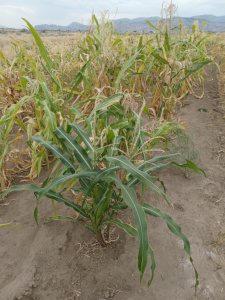
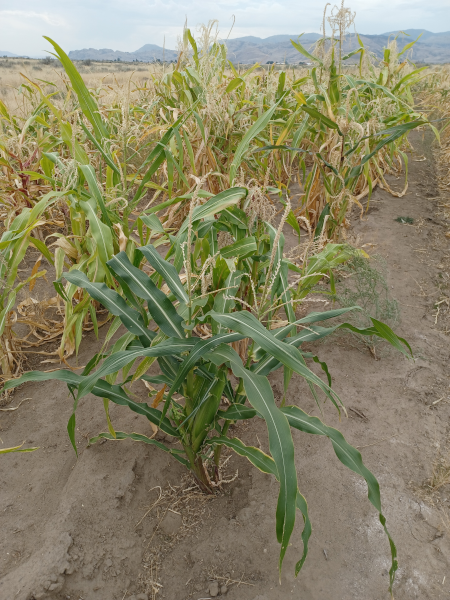
Hopi White / End Of Row 1
|
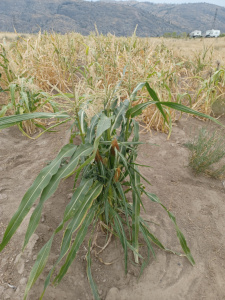
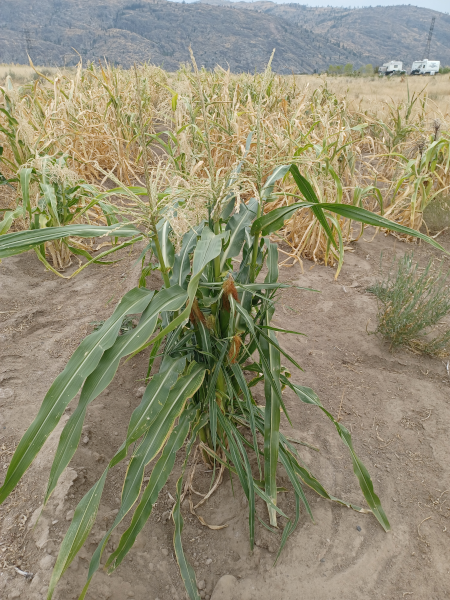
Hopi White / End Of Row 2
|
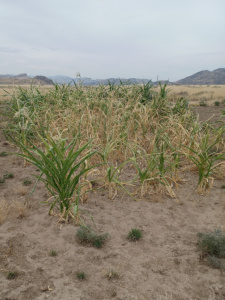

Concha White / Square Dry In Middle
|
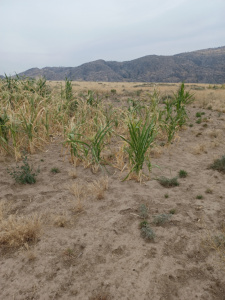
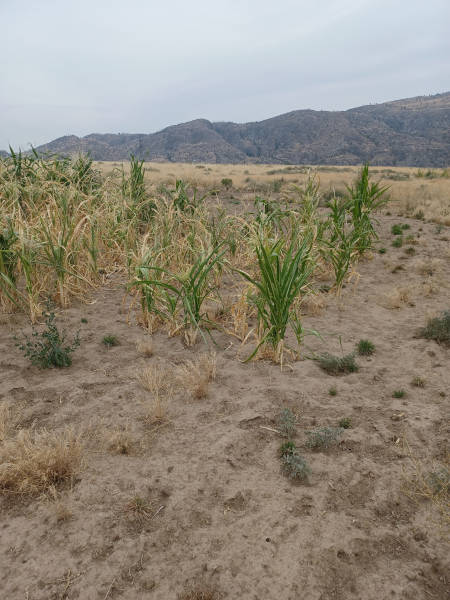
Concha White / Green South Edge
|
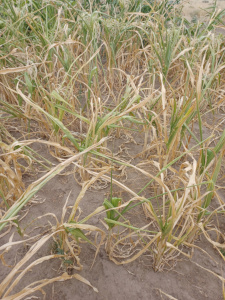
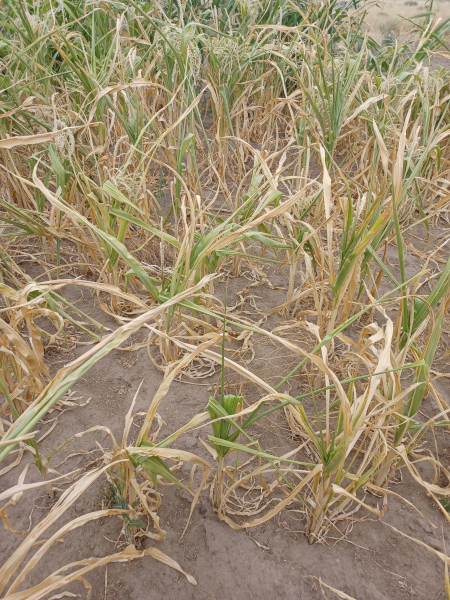
Dry Middle / Green North Edge Behind
|
Checking online various sources say the Hopi plant in blocks 5-7 paces apart, Akhima says "4 steps in between", another source says in blocks 4.9-5.7 feet apart, and Collins has pictures of hills he says are 20 feet apart. In some videos by Michael Kotutwa Johnson the hills look to be 7-10 feet apart and he also uses a tractor to plant in 6 foot rows. Akima plants hills 3 long paces apart and 3 long paces between rows and the hills are staggered so that hills in one row are midway between hills of adjacent rows. This would be 5-7 plants per every 81 square feet. In summary hill spacing is between 25 and 400 sq. feet per hill and hills are thinned to 4-7 plants per clump. If hills were 10 feet apart with 4 plants per hill that is 25 square feet per plant. Hills 20 feet apart with 7 plants per hill results in 57 sq ft per plant. Optimal spacing for a given location will depend on soil type, ground moisture, and local weather conditions. Most Hopi varieties I have tried develop multiple stalks from tillers and can produce up to 6 ears per plant so 4-7 plants per hill may not be necessary. Conversely more plants per hill may inhibit tiller formation resulting in a similar number of stalks per hill. Yield estimates done per hill can calculated independent of the number of plants per hill. Each corn ear can have between 0.25 and 0.8 lbs of kernels. If a hill produces 4 ears each or about 2 lbs per hill with hills 6 feet apart this would yield 1210 hills * 2 lbs or 2420 lbs / 43 bushels per acre. This seems to be a reasonable estimate since dryland wheat makes 42 bushels per acre in my region. Yields are understandably less than expected compared to an in a irrigated field.
One thing I noticed when researching again was the phrase that Hopi farming relies on "labor intensive" methods. I have been unsuccessfully trying to find a way to streamline the process of growing corn without irrigation but this isn't possible without specialized equipment for deep planting.
Fertilizer Adjustment For Reduced Plant Density
The roots of corn plant extend up to 10 feet around each hill to reach water and nutrients and broadcast fertilizer recommendations need to be adjusted to compensate for plant density and removal of nutrients by the crop. Irrigated corn density is 30000 plants per acre with an average yield of 177 bushels per acre. If we assume 5 plants every 49-81 sq ft that is 2688-4444 (81 sq.ft./7 = 3765) plants per acre or about 10 times lower plant density. Optimistically assuming dryland corn planted with correct spacing can make double the 42 bushels for wheat, 177 bushels / (42*2) bushels = 2 which means fertilizer should be reduced to 1/2 (based on yield) and up to 1/10 (based plant density) of the normal rate. It may be better not to reduce the fertilizer to 1/10th since the calculations below are based initially on dry land corn. Nitrogen rates of 150-300lbs per acre can be used with 150lbs per acre being more cost effective since increasing N does not proportionally increase yield.
Dryland Corn Recommendations 120-80-80. In Georgia dryland corn is planted 16000-18000 seeds per acre but expected yields in Georgia climate can be more than the national average for irrigated corn. Hopi corn is planted at much lower density but due to tillering and reduced competition for light may produce more corn per plant.
Reducing the below values by half probably wouldn't decrease yield by much, if at all. My supplier doesn't have and won't mix in Iron or Magnesium and the level of Zinc in MESZ not worth the increased price.
For 1 acre of corn | |
| 225 lbs Urea 46-0-0 | N 103.5 lbs/acre |
| 150 lbs 1152 11-52-0 | N 16.5 lbs/acre + P205 78 lbs/acre (up to 150lbs) |
| 167 lbs KCl MOP 0-0-60 | K2O 100lbs/acre (up to 150lbs) |
| 52 lbs FeSO4 31% Iron Monohydrate | Iron 16 lbs/acre |
| 30 lbs Zinc Sulfate 35% Zinc | Zinc 10 lbs/acre |
| 50 lbs MgO 45% Magnesium Oxide | Magnesium 22.5 lbs/acre (*50-100) |
| 18 lbs MnSO4 28% | Manganese 5 lbs/acre |
Shortlist for 1 acre of corn | |
| 225 lbs Urea 46-0-0 | N 103.5 lbs/acre |
| 150 lbs 1152 11-52-0 | N 16.5 lbs/acre + P205 78 lbs/acre (up to 150lbs) |
| 167 lbs KCl MOP 0-0-60 | K2O 100lbs/acre (up to 150lbs) |
| 18 lbs MnSO4 28% | Manganese 5 lbs/acre |
| Boron Coating | - added by supplier - |
| Nitrogen Stabilizer | - added by supplier - |
Seed Preparation / Pre-Sprouting
It is best to soak the corn seeds before planting but it is not necessary. Seeds should be soaked at least 8 hours before planting. Old seeds may be dry and benefit from multiple soak/rest cycles. Soaking more than 12 hours can damage seeds due to a lack of oxygen so it is better to soak 8-12 hours, drain, rest 8-12 hours, then soak again 8-12 hours, and repeat until roots begin to develop but are not extending from the kernels. Seeds which are too far along in the germination process and have emerging roots are easily damaged by handling. It is best to discard floating seeds which may not germinate and it is better to plant soaked seeds right away as refrigeration can damage soaked seeds. We soak our seeds overnight, drain in the morning, rest for 8-10 hours, and plant the next evening.
How To Plant & Planting Depth
Hopi corn is adapted to deep planting and deep planting helps seeds absorb enough water to reach the soil surface and later reduces lodging. Till the soil to remove all competing vegetation, spread fertilizer, and till the fertilizer in before planting. A cultipacker can be used to firm the soil before planting which will also reduce evaporation, loose tilled soil looses water more quicikly. Plant 6 to 8 inches deep in loose soil. It is recommended to scrape a clear area, remove the soil by hand, plant 7-10 kernels, and place the moist back in the bottom of the hole with the top dry soil back on top. We use a 2 inch augur with a drill and drill an 6-8 inch hole, plant the seeds, and push the soil back in the hole. It is best with one person drills the holes and another follows behind planting seeds so that holes don't collapse before seed placement and no holes are missed. Push the soil with a shoe or hoe to cover promptly reducing soil evaporation and the chance that exposed seeds will be eaten by wildlife. If using an augur and doing many hills an extension cord drill will work better than a battery powered drill. The drill will get hot after about 400 holes so stop and give the drill time to cool down or alternate with another drill. Do not drive a tractor directly over planting holes. It is beneficial to water each hole sparingly if the soil is very dry, but it is not necessary.
A middle buster can be used to make a 12 inch furrow and corn planted in bottom of the furrow. Pull a rebar harrow behind the tractor to fill in the furrows by driving on the high parts between the furrows. Make sure to make enough passes and put the tines on the harrow down for at least 1 pass to get adequate coverage. A cultipacker can be used to firm the top of the furrows. Plants will be blown over and soil moisture loss increased if furrows are not well filled.
Thinning & Hilling The Corn
When the corn is 8-12 inches tall remove a couple inches of soil around the plants and pull the weakest in each hill leaving 4-7 plants per hill. After thinning pull surrounding soil back around the stalks and firm the soil. If corn was planted in a trench or depression move soil to fill in the depression and as the corn gets taller pull more soil around the stalks. The extra soil acts as an inorganic mulch and reduces evaporation.
Pests
Grasshoppers, birds, and rodents can damage corn and reduce yield. Tilling kills grasshopper eggs in the soil. For organic control of grasshoppers spread a 4 foot band of diatomaceous earth with a flour sieve around the field and between every 4 rows. Grasshoppers hop onto the treated areas and they will die after a few days. For a small field put screen sleeves over the top of the ears which allows pollination but prevents grasshoppers from eating the silk. The screen can be left on to reduce damage by birds. Birds peck through the husk at the top of ears but usually only about 25% of the ear is damaged. For rodents mouse traps with peanut butter is effective.
Harvesting & Storage Of Hopi Corn
Hopi Corn can be harvested at the milk stage for eating fresh like sweet corn when the silks have turned brown. If harvested earlier the kernels will not be as sweet or fully developed and if too late will be slightly starchy. Blue corn is sweetest when still white but gets starts to get starchy just as it starts to turn from white to blue..
If planning to store the corn or use it for seed leave it as long as possible on the stalk or until the husk and stalk are dry. Immature corn kernels will have a lower germination rate. Hopi Blue Corn that is dark or medium blue should have greater than 90% gerimination rate while lighter colored less mature blue corn will have a germination rate of 75% or lower. For long term storage allow corn to dry in the field till moisture is less than 15%. Corn will dry rapidly when temperatures are high and humidity is low but decreases to 0.4% percentage points per day when average daily temperature is 55°F. Corn that is not yet dry on the stalk can be damaged by freezing temperatures resulting in decreased seed viability. Late harvested corn can be brought indoors finish the drying process. If moisture higher than 15% store it is better to store on the cob with ventilation or mold could grow decreasing the viability of the kernels.
Back To Hopi Dryland Corn Experiment 2023
Winter Wheat Planting 2023